The Brooklyn Paper writes about a new coffee table book about people's literary tattoos — not so much literate tattoos but rather tattoos literally about literature:
Friends Eva Talmadge and Justin Taylor noticed a rise in these literary tattoos, from highbrow pieces inspired by James Joyce's "Ulysses" to the covers of the "Twilight" books. They sent out a call for submissions, and the tattoos came pouring in.
The resulting anthology has more than 150 color photographs of literary tattoos, ranging from lines of verse, quotations from authors, illustrations of scenes depicted in novels and poems, and even a flaming typewriter.
"We tried to present the crème of the crop," said Taylor, a Bushwick-based author who, as far as these things go, is tattoo-less. "We wanted a lot of diversity and to be as all-encompassing as we possibly could. You'll find some high literary stuff in there — Pynchon, T.S. Eliot, 'Moby Dick' — as well as J.K. Rowling and Stephen King."
Now maybe this does illustrate the importance of literature, the timelessness of the great themes, the power of words. Or maybe it just confirms what I've long thought about tattoos, which is that there isn't anything really worth permanently inking on your skin. I mean, do you really want a tattoo of something you do to kill time on a cross-continental flight?
It's not to say that Moby Dick isn't a classic but rather that I'm not sure I got the same thing out of the book as someone who has a tattoo of it.
I only read Moby Dick fairly recently, in a spate of wanting to finally get out of the way some of those "timeless," "important" books that have clogged up our bookshelves for years. So I packed it in my bag and took it with me to work, and knocked out that bad boy in eight lunch hours at a chain coffee shop in Midtown.
If I saw a tattoo of Moby Dick, here's what would come to mind.
1) Sperm. Specifically, Chapter XCIV — "94" to you and me — "A Squeeze of the Hand":
Squeeze! squeeze! squeeze! all the morning long; I squeezed that sperm till I myself almost melted into it; I squeezed that sperm till a strange sort of insanity came over me; and I found myself unwittingly squeezing my co-laborers' hands in it, mistaking their hands for the gentle globules. Such an abounding, affectionate, friendly, loving feeling did this avocation beget; that at last I was continually squeezing their hands, and looking up into their eyes sentimentally; as much as to say, — Oh! my dear fellow beings, why should we longer cherish any social acerbities, or know the slightest ill-humor or envy! Come; let us squeeze hands all round; nay, let us all squeeze ourselves into each other; let us squeeze ourselves universally into the very milk and sperm of kindness.
After Jen and I visited the Taj Mahal, the earnest tour guide turned to us and said, "There are two people in the world — those who have seen Taj and those who have not; You, my friends, have now seen Taj." In a similar way, the world changes once you have read Melville's sperm chapter.
I guess it depends where you read it, too. I don't know how I'd feel taking that in on a cross-continental flight. In the chain coffee shop, it came off like this: "Would that I could keep squeezing that sperm for ever" — [fellow patrons looking productive on their laptops] Tap tap tap tap-tap-tap tap tap tap, tap tap tap tap-tap-tap tap tap tap — "In thoughts of the visions of the night, I saw long rows of angels in paradise, each with his hands in a jar of spermaceti" — skweeek! [the squeal of a wooden chair scraping the floor], skrrrrroneeeek! [a table moving lazily against the tile] — "A sweet and unctuous duty!"
On the one hand, yes, nineteenth-century realism. On the other hand, that's what you want to tattoo?
2) How About An Editor? While the sperm chapter almost rises to a level of pure tattoo-worthy genius, I'm a little perplexed about the long passages detailing stuff like the "interior structural features" of whales (Chapter 103, "Measurement Of The Whale's Skeleton"). Here you are, page 650, and Melville goes on a tangent about the whale's skeleton — you think, we're in the home stretch, and this? It's less realism than an Asperger's symptom.
Chapter 105 details arguments for why or why not the whale's magnitude will or will not diminish — Pliny is consulted, comparisons are made between herds of whales and herds of buffalo (imagine what would have happened if Melville decided to write a book about buffalo — you'd be tattooing a buffalo somewhere), and the eventual oil-for-bloodletting conclusion that the species is "immortal." Maybe you don't realize that when you tattoo Moby Dick on yourself, you're actually tattooing a rationalization of our resource-depleting society, and when I see that tattoo, the only thing I think — besides sperm and besides absent editors, that is — is that Moby Dick will kill Mother Earth.
It's not until Chapter 106 — 106! CIII! — that the book starts to coalesce into something you "recognize" — in the way you "recognize" Jeopardy! questions, bumper stickers and I guess tattoos, too. The chapter about Ahab's Leg sort of jumpstarts that cool psychological sketch Melville does that you always hear about, but 665 pages and 105 chapters of setup? Really? You know what a literary agent would say about this if she consented to reading a draft?
Maybe the person who tattoos Moby Dick on him or herself had a different experience with the book. That's OK, I get that . . .
Re: Pynchon/Joyce . . . I guess if you make it through Gravity's Rainbow or Finnegans Wake then you deserve the tattoo.
More from the Brooklyn Paper:
In addition to Talmadge, there are Bryan Waterman's portrait of Walt Whitman; William Clifford's seven tattoos, the most from one person featured in the book; Cristina Moracho's Albert Camus tattoo; and Stephanie Anderson, a manager at Greenpoint bookstore Word, who has nine literary tattoos, including "Words, words, words," from "Ulysses."
Whitman, eh? Quite a beard, no? But a tattoo?
I also read Leaves of Grass around the same time as Moby Dick. I actually had two copies, both of them gifts (maybe the gift givers thought I looked like Whitman or something?), and their presence on our shelves haunted me for years. My impressions of Whitman definitely included "Camerado," "Calamus" and "O Captain, My Captain," but my overwhelming impression was someone who was somehow both death-obsessed and a straggler. Chapter 34, "Sands at Seventy," is as much about Whitman as "that guy" as it is about an aging poet:
Shunning, postponing severance — seeking to ward off the last word ever so little, e'en at the exit-door turning — charges superfluous calling back — e'en as he descends the steps, something to eke out a minute additional — shadows of nightfall deepening, farewells, messages lessening — dimmer the forthgoer's visage and form, soon to be lost from aye in the darkness — loth, O so loth to depart!
Which is to say, Whitman was the kind of guy who just didn't know when to leave, who you'd see to the door only to have him remember some bleary-eyed 2 a.m. detail that could have waited until the morning, or even the next time he came by. And it's only after Whitman finally leaves that you close the door and sigh: Look at all those dishes, look at the chip dip hardening on the sides of that serving dish, look at all those crumbs caked into the carpet; this will take hours to clean up, and it only gets later as you hover over the pile of dishes in the sink wondering where to start. Maybe that sort of thing flies in Camden, but . . .
There are no hits for "Henry Miller" on the book creators' website. Can you imagine that one? If I saw a Henry Miller tattoo, the first thing I'd think of would be "cunt," just like the Amazon Key Phrases feature says:
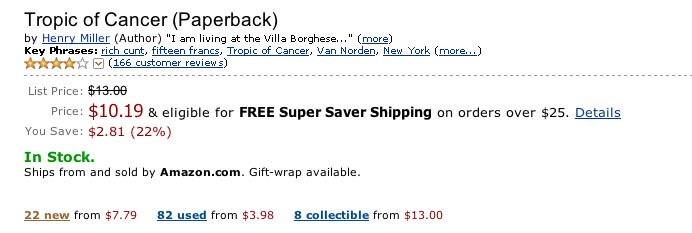
Sorry, did I write "cunt"? I meant "rich cunt." (This was from March 2009, when our book club read Tropic of Cancer, but the key phrases feature is still on the book page, just scroll down.)
True to form, here's page five:
O Tania, where now is that warm cunt of yours, those fat, heavy garters, those soft, bulging thighs? There is a bone in my prick six inches long. I will ream out every wrinkle in your cunt, Tania, big with seed. I will send you home to your Sylvester with an ache in your belly and your womb turned inside out. Your Sylvester! Yes, he knows how to build a fire, but I know how to inflame a cunt.
Seriously, Tropic of Cancer reads like the ten plagues of Egypt. Second paragraph: Lice. Second page: "The world is a cancer." Third page: Six-foot whale penises and Jews. Page 5: Reaming out "every wrinkle" in a cunt. Page 7: "Foggy farts" on windowpanes. Page 16: Getting erections from statues. Page 20: Cigar-smoking fetuses and sap-oozing thighs. Page 23: Syphilis! Page 35: Bright red cabbage breasts. Page 45: A golden-toothed prostitute's "bushy twat." It's relentless! And that's even before the bed bugs come in the picture.
I'm not always sure when or whether Jen is "Irishing up" a story, but she tells a good one about a guy she knew back in high school who was so psyched to have met the band Goldfinger that he told them he'd was going to go right out and get their logo tattooed on his back. Then he woke up the next day to discover the logo of the band Goldfinger tattooed on his back. Jen said that he went back to the tattoo artist and the artist decided that there wasn't much he could do to conceal it except perhaps to fill it in to look like two Indian maidens in a canoe, which is how this guy got a back tattoo of two Indian maidens in a canoe.
The point being, just who are these guys that you're tattooing on yourself? Part of it I think has to do with the bombastic nature of "the novel." I'm not totally sure I understand why something that clocks in at 100,000 words is something that we should or need to celebrate. I'm guessing there are few Leonard Michaels tattoos out there — but that's clearly his own fault, because if he wanted tattoos, he would have obviously wasted much less time writing all those short stories.
And going back to the tattooization of literature, I felt like reading some of these classics outside the context of a college seminar kind of highlighted how strange the books themselves actually were. It was freeing to see Moby Dick, for example, as less "a symbol for many things, including nature and those elements of life that are out of human control" (Wikipedia's thoughts, not my own) than a brilliant description of whale sperm sandwiched by 800-plus pages of crazy shit. And I felt comfortable zoning out during Books 33 through 35 of Leaves of Grass. And I didn't kick myself for skipping entirely On The Road.
I mean, can you imagine someone getting a Jonathan Franzen or Nicole Krauss tattoo? Right? Right?
Right?
Posted: October 25th, 2010 | Author: Scott | Filed under: Books Are The SUVs Of Writing, Clickthrough | Tags: Brooklyn, Cunt, Goldfinger (The Band), Henry Miller, Herman Melville, Moby Dick, Reading Books, Skin Art, Sperm, Walt Whitman
Normally we'd be home watching stuff like Game Sixes, if there are Game Sixes to be watched, but it was a mixture of prior commitment and hubris that took us to Staten Island to participate in the latest Staten Island Pub Crawl during Game 6 of the NLCS. "Commitment" because we hadn't done a pub crawl in some time and "hubris" because, well, who would have thought this thing would have gone six games? Turns out that the Giants are on a major league streak right now . . .
I guess it could have been worse — had the Yankees beat the Rangers on Friday night, I think Game 6 of the NLCS would have aired in the late afternoon, which would have meant that we would have been on subways, ferries and trains for much of the game. As it turned out, Game 6 started at 7:57 (I never understood the :57 of MLB playoff start times), so we were able to monitor the progress of the game during stops along the crawl.
Cucina Di Napoli, Tottenville
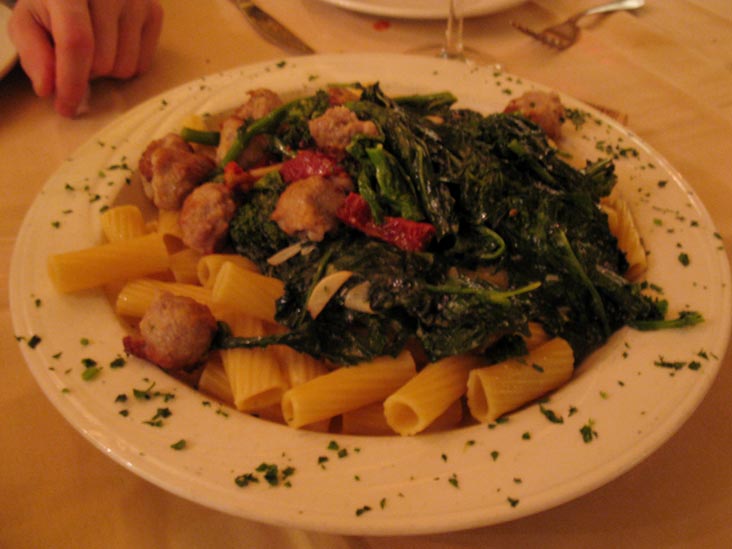
Things started out pretty well — we were carb-loading at Cucina Di Napoli in Tottenville when the Phillies scored two runs in the bottom of the first inning and Jen was excited as we walked to Atlantic Station to get to our next stop. Our friend Bates, a Red Sox fan who (at least for one night) was sympathetic toward the Phillies, cautioned that the offense still looked weak, which of course was true but which also didn't mean much if Oswalt could hold back the Giants.
So it was a tiny bit worrying that some sort of error (Jen saw it on her phone during the train ride to Great Kills) lead to at least one San Francisco run as the Giants tied the game in the top of the third, but it was still early in the game.
Talk of the Town, Great Kills
We got to Talk of the Town in Great Kills in time to catch the bottom of the third inning, including that bench-clearing flareup. I was a little bit surprised to see two apparent Giants fans sitting at the bar. Things still looked good even after the Giants pulled starting pitcher Jonathon Sanchez and Ryan Howard was up to bat with no one out and runners at first and second. Of course Howard struck out; this would stick out in my mind later on.
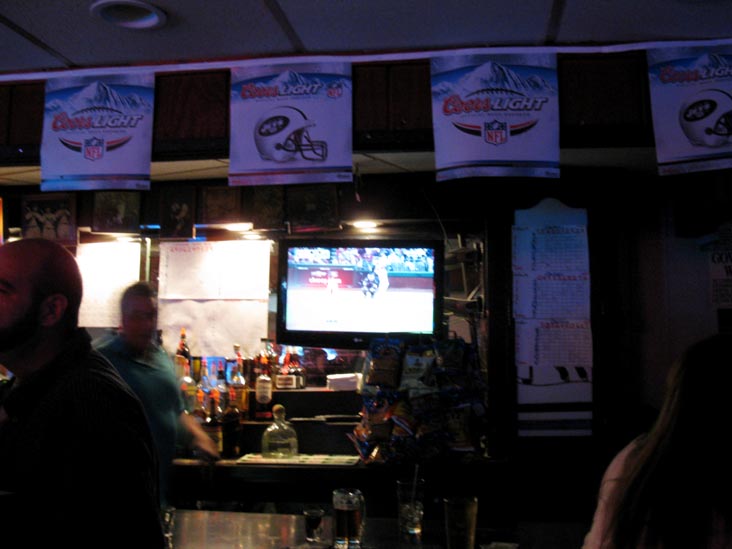
I continued to watch the game out of the corner of my eye while we tried to overtake "Larry" and "Larry Who" on Erotic Photo Hunt (note: the Penthouse version of the game is much more difficult than the generic version — too many dumb subtle differences between the two photos). Still 2-2 when we left Talk of the Town and still 2-2 when we rolled into Night Gallery in New Dorp.
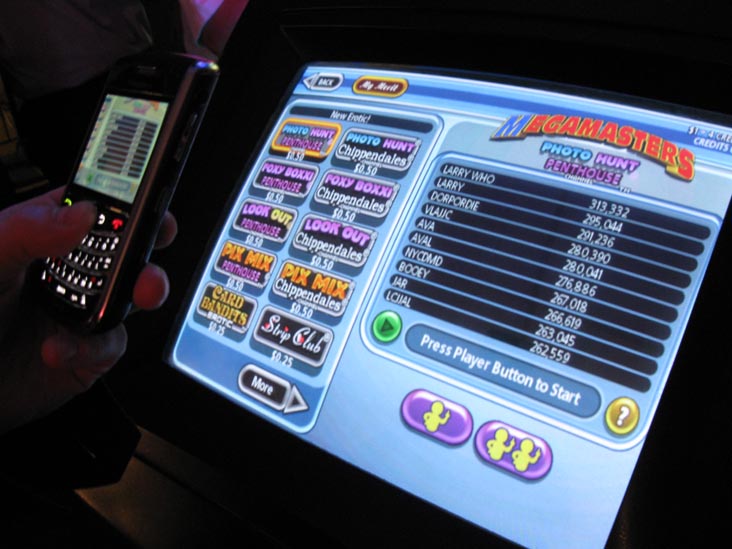
Night Gallery, New Dorp
Now Night Gallery is a little bit different than the rest of the places we usually stop at on the crawl. The place has a little bit of a dodgy history, and on this particular night, it felt like we came in a little too much like gangbusters. It's not always so low key, to be sure — we've had good nights when whoever is the bartender there is friendly and whatever patrons are around don't seem to mind a bunch of yahoos invading their space, but there was something a little off about the "vibe" there on this night — to me at least. I was feeling like we were clogging up the path between the door and the back, then feeling like we were too loud as I chatted with some folks we were with. Or it could have just been that I was too preoccupied with watching Ryan Madson pitch the seventh and eighth innings. The conversation was veering off into politics when I noticed that overused camera angle that Fox employs when a runner crosses home — you know which one, the low angle looking up at some slugger's mammoth legs as he's reaching out to high five whoever is on deck. That was when I silently took in the fact that Juan Uribe just homered to put the Giants up 3-2.
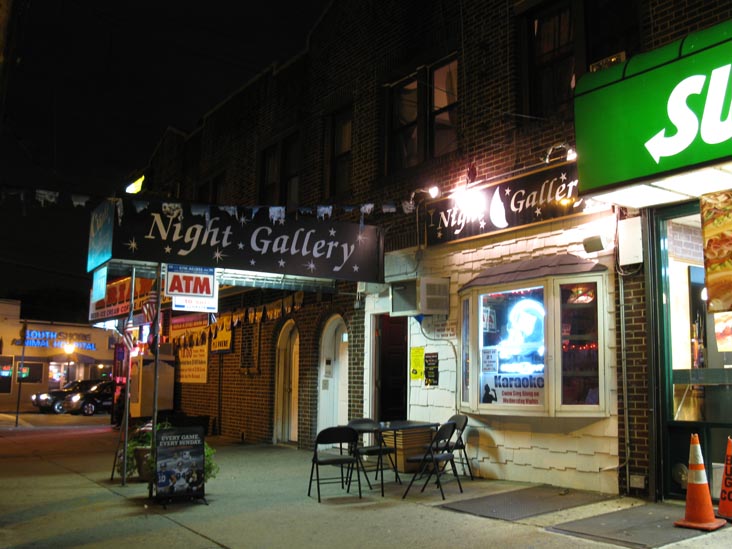
I still thought there was hope when we left Night Gallery until I realized that it was already the top of the ninth inning. Jen kept following the game on her phone and we saw there were two relatively quick outs. Then Rollins walked . . . and Utley walked . . . and Howard was up to bat again . . .
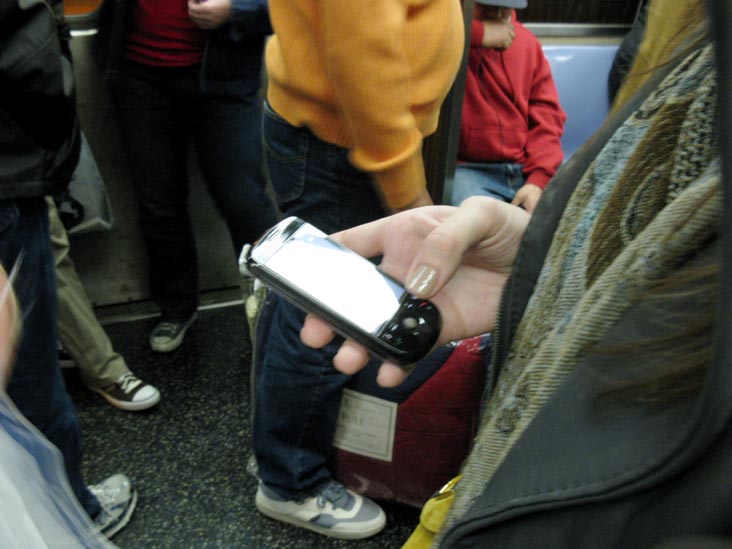
Lee's Tavern, Dongan Hills
We got off the train at Dongan Hills and entered Lee's Tavern to find the patrons gathered around the front following the game on the television above the bar. They — I'm assuming they were Mets fans — were clapping loudly as Howard swung at another strike. 2-2 count, bottom of the ninth, and another ball makes it a full count.
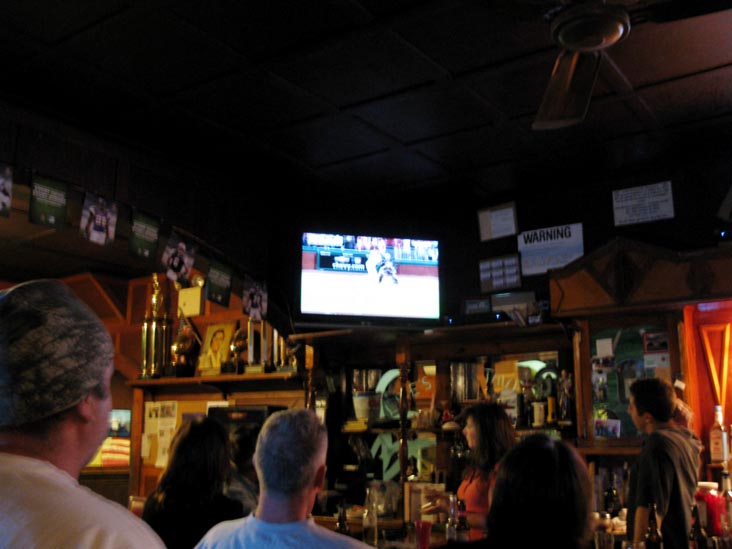
"One more strike and the Phillies are going down!" the guy next to us yelled out. I guess Mets fans have to get inspiration from somewhere, and it would come down to Brian Wilson and that freaky-ass Just For Men Black Bart beard versus Ryan Howard.
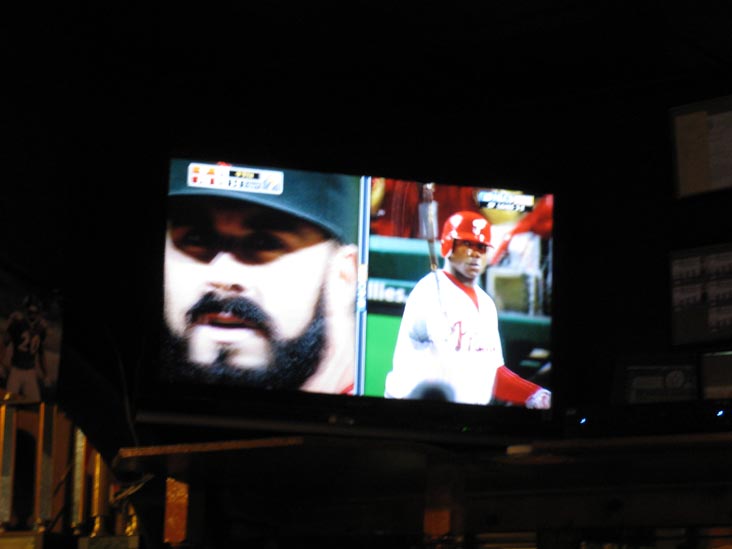
No matter how good your team is, there's a sickening feeling about your chances in this position. As Jen put it, the Phillies fans in the stands looked like they were going to barf. I think you watch that kind of situation and know that it probably won't turn out well — which also makes that feeling all the more awesome when it actually happens to go well. Of course Brian Wilson got Howard to look at a sinker just in the zone for strike three. Those are how those situations usually work out.
"Yes! Yes!" the guy next to us yelled as he pumped his fists. I think he quickly realized from our lack of shared enthusiasm that we might have been rooting for the Phillies so he thought to add that Howard had to at least swing at that pitch, that it was too close. He was obviously correct — and Mets fans should know — it sucks a whole lot harder to take a called third strike than to at least take a swing at something (spin it however you want from here). (Part of me wants to remind the guy that the number two candidate for the Mets vacant GM position is the same person who ran the Diamondbacks into the ground.) (Part of me also wants to remind Giants fans — if we knew any, that is — that Cody Ross is a free agent after this year.)
It serves us right I suppose, rootless as I guess our lives are, to have to watch the Phillies lose among a bunch of frustrated Mets fans in a Staten Island bar, but, jeez — ouch — that was rough.
They seat our group in the annex room on the other side of the bar where chairs are stacked on tables. I was zoning out watching #11 Missouri closing out an upset of #1 Oklahoma, which I guessed was good for Boise State, but it was hard to get excited about anything sports related right then. Meanwhile, Cooley baits Bates about the various Red Sox-Yankees series this past year. Cooley's feeling less stung 24 hours after the Yankees own Game 6 loss. Bates recounts all the injuries the Red Sox had in 2010. I ask Cooley about whether Girardi will come back, if Posada will be eased out of an everyday role and if she really thinks they can get Cliff Lee. We scarf pizza (Lee's is still good, no matter how crazed their Mets clientele is) and make it out in under an hour.
On the way over to the train Bates recounts all the greatest disappointments in his personal Red Sox history. For him, the "best" series he ever saw wasn't the epic 2004 Red Sox-Yankees ALDS but rather the 2003 Red Sox-Yankees ALCS. I have a hard time abiding this contrarianism, but Bates made an interesting case: Of course the Red Sox lost that series, but the way they lost it really stands out — Tim Wakefield giving up that home run to Aaron Boone, Rivera praying on the mound, etc. In Bates' view, 2004 was not possible without 2003, and having Tim Wakefield lose it in 2003 was OK with him, Wakefield being his favorite player of all time.
Knuckleball pitchers really are cool, and to me there's this awesome mystery in how and why a knuckleballer will have his fingers work one day and not the other — Wakefield's knuckleball obviously was not working in Game 7. Bates adds that he loved that Joe Torre said something along the lines of how Wakefield was the best player he never got to coach and that it was classy that he called out Wakefield during the post-game press conference. (I'm amazed at how well Bates remembers baseball stuff — looking up stuff today, it seems he's remembering everything 100 percent accurately — I wonder if this is a Red Sox thing or something.)
The point being, according to Bates, is that it's much better to lose in seven games (or five games) than to lose in six games. There's something especially horrible about losing in six for some reason . . . this is true.
The train to St. George was delayed by some mechanical glitch — Bates joked that it sounded like they were riding on square wheels — and we lost a few more from our group as they ran for the 2 a.m. ferry. We circled back to the last stop, a new place, Karl's Klipper in St. George (The Real McCoy has since been replaced by a new pizza place that seemed a little too Belmar for our speed).
There are some girls in Karl's Klipper yelling out the lyrics to "Sex on Fire," which was Jayson Werth's walk-up music in 2009. My mind drifts toward Jayson Werth and his contract year . . . and I'm still thinking about Howard looking at that last strike. Meanwhile, Jen goes into a bit about Morgan Freeman, which probably doesn't merit an explanation beyond which to say that I think she was somehow trying to take her mind off of the loss.
It's 2:15 or so and most of us are tired and hinting that it would be nice to get on the 3 a.m. ferry. We finish the last of our drinks and start to get our stuff together. By this point, Bates has donned some sort of Halloween wig and is joining in with the girls at the bar: "Just gonna stand there and watch me burn! Well that's alright because I like the way it hurts!" We finally get him to ditch the wig and leave the sing-a-long behind. We make the 3 a.m. ferry back to Manhattan in plenty of time — fortunately we can still buy 16-ounce tall boys, and that really is the best deal in town.
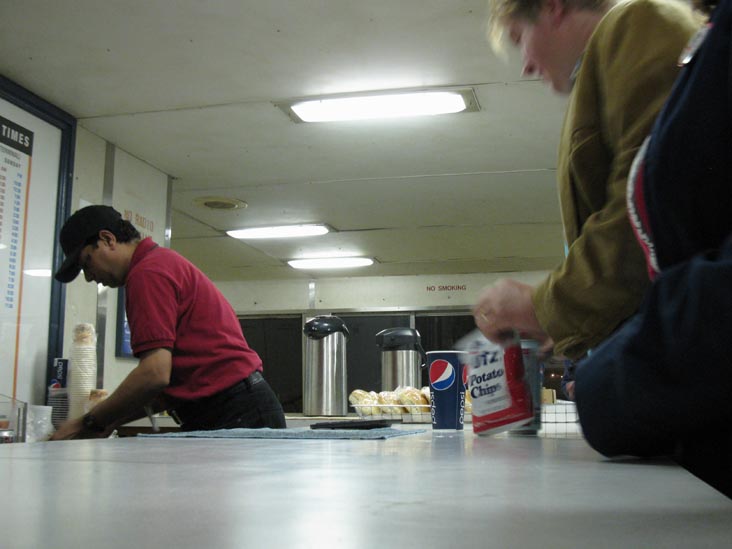
We leave everyone behind at Water Street with their cabs home and Jen and I head over to the Bowling Green station. It's not until we get to the subway platform that she admits that she's sad. I agree. Then the thing that first bothered me about Howard striking out in the third inning finally comes into focus.
The other day ESPN's Jim Rome "burned on" the fact that Jimmy Rollins wasn't bunting the runner over in Game 4, the game where the Giants went up 3-1 in the series. What really bothered me about that third inning Howard strikeout wasn't that he struck out — we had seen Howard strike out that way many times over the course of the season — but rather that he struck out with runners on first and second and no one out. Now I know it's not the kind of thing that cleanup hitters "do," but in a must-win Game 6, why the fuck can't Ryan Howard bunt? I know it's lame or whatever to have your big slugger bunt like he's some weakling shortstop or pitcher or whatever, but wouldn't you rather have Ryan Howard swallow his pride and help manufacture a run than have the team end its season? I don't get it. And it doesn't make sense when Charlie Manuel already went "unorthodox" by pitching Roy Oswalt in relief in Game 4 before some of his other relievers. Ryan Howard should have sucked it up and bunted. I'm convinced this is a big reason they lost this game.
On the subway platform at 4 a.m. Jen thinks Charlie should be fired, but reconsiders the next morning — there's only so much a manager can do, and besides, they had their chances last night — a few of which just went the wrong way because of dumb luck. Neither of us have read any of the Philly sports sites yet. It's still a little too raw. Maybe tomorrow.
Posted: October 24th, 2010 | Author: Scott | Filed under: The Thrill Of Victory And The Agony Of Defeat! | Tags: Baseball, Erotic Photo Hunt, Phillies, Red Sox, Staten Island
I recently took — and passed with a star, meaning a score over 120 (I got a 123)! — the New York City Sightseeing Guide Exam that is given by the City's Department of Consumer Affairs, which means that I am now a licensed sightseeing guide.
The sightseeing guide exam was rewritten in 2003 because it was outdated (9/11 changed a lot, not least of which apparently being several questions related to the World Trade Center). The new exam is apparently more in-depth than the last one, and is intended to better test the abilities of the tour guides that the City of New York licenses. The accuracy of the information from guides on certain buses has been called into question over the years (see also) so I guess the City owes it to tourists to get some stuff right.
Jen took — and passed! — the new exam several years ago, but she was no help when I asked her what was on the exam. I don't think she was being competitive either — she just didn't remember. So I asked another person we know who took — and passed! — the exam and she had some good advice: "Major rule is the Charter buses cannot go north on Park Ave past ….I think 23rd St. That is the one they really care about. Also study FDR. AIA guide book is very helpful. Random….make sure you know what Wave Hill is!!!"
These are good tips — part of the sightseeing exam, as they'll tell you when you read the study guide (.pdf), is knowing the rules for charter buses. Even if you're not driving a bus, or if you think of tours as walking tours, DCA expects you to know the rules for charter buses. Here is a link that has everything you need to know. And just so we're clear, the rule is actually that charter buses can't drive on Park Avenue north of 42nd Street, which makes sense if you think about Park Avenue north of Grand Central. And if you've ever rented a U-Haul, you already know that you can't drive it on the parkways, so that's what she meant about using the FDR. I had visited Wave Hill before, so I knew that part, but the test is pretty inventive with one question I had (they cycle through several versions apparently) that combined both charter bus rules and Wave Hill, giving you a choice of four routes to take to Wave Hill that presupposes you know not only where Wave Hill is but how to avoid the FDR while getting there.
One of the books they suggest you study is Blue Guide New York by Carol von Pressentin Wright, so I checked it out of the library and studied it over the course of a couple of weeks — not a lot, but I definitely read Francis Morrone's architecture section more than once (New York City architectural styles are important to know).
Feeling macho, I resisted Googling "New York City Sightseeing Exam Questions" for a while . . . until I finally did, and found these links: 1) An NPR piece about the new exam with some sample questions; 2) Norman Oder's criticism (and other criticism) of the new exam; and 3) Justin Ferate's sample quiz (Ferate wrote the new exam). (This blog entry also had some useful tips.)
I'm glad I came across the NPR piece because it featured this question: "The physical size of the Bronx is approximately the equivalent of what European city? (a) Paris, France, (b) Copenhagen, Denmark, (c) London, England, (d) Brussels, Belgium." My first response was "Are you fucking kidding me?" There's that old Brooklyn booster piece of trivia about how if Brooklyn were its own city it would be the fourth largest in the U.S., but who really cares that the Bronx is geographically similar in size to Paris? (I had to look that one up on the Wikipedia, and convert square kilometers even — it was a pain!)
I think Ferate explained (or I surmised — can't find it right off the bat) that the exam is written to be educational for the tour guides themselves — so it makes sense that they'd drop in seemingly impertinent details like the geographic size of the Bronx. That said, one tip I have is to read the long (sometimes really long) text for each question and skip questions that you're not sure of because the test questions often have answers embedded in them that pop up in later questions. Although I read each question in its entirety, I didn't skip any — if I had I would have scored higher for sure. One question I missed that I shouldn't have missed given that I used to work at the Parks Department was about Robert Moses. The gist of the question was that Moses built or had a significant impact on basically all this stuff in New York and elsewhere; I overthought it by first questioning Moses' substantive impact on Central Park (he didn't build most of the stuff he wanted to build there, and I think the plans for the Great Lawn predated "his" involvement in the WPA-era project, though yeah, he put a lot of playgrounds in there for sure) and Moses' impact on Van Cortlandt Park (I don't think he did all that much in Van Cortlandt Park actually — it dates to the 1880s — though yes, I guess there's that highway he ran through it). But no matter — I knew about the Bronx-Paris question beforehand, so we'll call it even. Oh, and a "FAM Tour," if you didn't already know (I got this question wrong) is a "Familiarization Tour" — I gather that's an industry term or something . . .
It was fun to visit DCA — they have all sorts of licenses, and if I wasn't worried that they'd freak out if I pulled out a camera, I would have taken a picture of the wall of license applications that feature everything from Bingo Game Operator to Laundry Jobber to Motion Picture Projectionist (really?). New York City loves to license stuff. And the staff was really nice — everyone I talked to was really psyched that I scored a 123 . . . I felt proud!
So now that Jen and I both have our NYC sightseeing guide licenses, what will we do with them? We had this idea to do tours — not the typical There's-The-Empire-State-Building Tour but rather a sort of Come-Hang-Out-With-A-Real-Life-Person Tour that would replicate the experience of coming to New York and visiting a friend of yours. It's not completely hashed out in our minds, but I think it would combine the usefulness of a so-called "FAM Tour" with the kind of fun stuff you'd get from visiting someone you know. Sort of like, hey, there's the skyline and that's X, Y or Z building and then here's the Newtown Creek, which has more oil spilled down there than the Exxon Valdez — i.e., stuff that maybe goes off of the typical NYC & Company message. I really enjoyed all the tour guides we had when we went to Peru back in July, and after we got back I started to think more seriously about it — that and it's actually a lot of fun to show people around — even if I'm not 100 percent clear about the difference between Federal Style and Greek Revival architecture on Washington Square North (it's the latter, if my Blue Guide study was correct)
In the meantime, Not For Tourists, the guidebook people that Jen and I have done some work for over the years, is doing a Chinatown "Exploration" on November 6 that I will lead, assuming they get enough people to sign up for it. (I tried to get Craig to call it a "Not For Tour" but maybe it was too strange sounding.) It's $50, but for that price you also get some street food, a drink at the end of the "tour" and also a typo-free copy of the 2011 Not For Tourists Guide to New York City, which I had the privilege of proofreading.
And if you're interested in Jen and me taking you and your (hopefully not too well-informed) buddies around, feel free to e-mail us at info -at- bridgeandtunnelclub.com . . .
Posted: October 23rd, 2010 | Author: Scott | Filed under: Do The Hustle | Tags: New York City Tour Guides, Robert Moses, The Size Of Paris, Van Cortlandt Park











